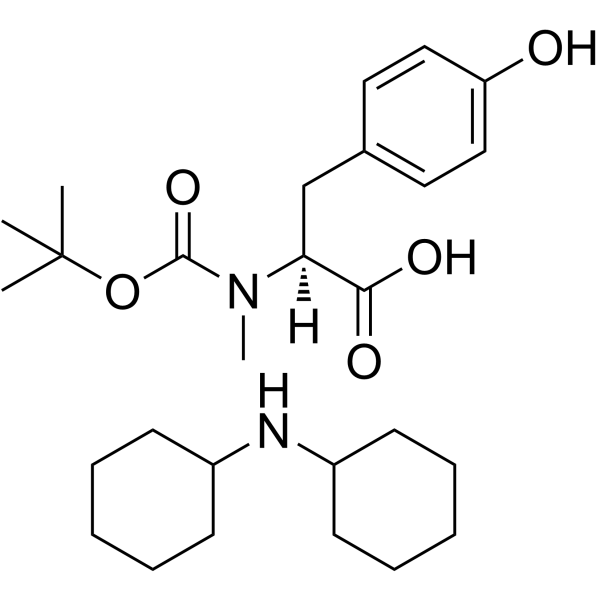95105-25-2
| Name | N-cyclohexylcyclohexanamine,3-(4-hydroxyphenyl)-2-[methyl-[(2-methylpropan-2-yl)oxycarbonyl]amino]propanoic acid |
|---|---|
| Synonyms |
L-Tyrosine, N-[(1,1-dimethylethoxy)carbonyl]-N-methyl-, compd. with N-cyclohexylcyclohexanamine (1:1)
N-Methyl-N-{[(2-methyl-2-propanyl)oxy]carbonyl}-L-tyrosine - N-cyclohexylcyclohexanamine (1:1) 2-[tert-butoxycarbonyl(methyl)amino]-3-(4-hydroxyphenyl)propanoic acid boc-n-me-tyr-oh.dcha 3-(4-hydroxyphenyl)-2-[methyl-[(2-methylpropan-2-yl)oxy-oxomethyl]amino]propanoic acid 3-(4-hydroxyphenyl)-2-[methyl-[(2-methylpropan-2-yl)oxycarbonyl]amino]propanoic acid N-(tert-Butoxycarbonyl)-N-methyl-L-tyrosine - N-cyclohexylcyclohexanamine (1:1) MFCD06658544 N-tert-Butoxycarbonyl-N-methyl-L-tyrosine dicyclohexylamine salt |
| Description | Boc-N-Me-Tyr-OH.DCHA is a tyrosine derivative[1]. |
|---|---|
| Related Catalog | |
| In Vitro | Amino acids and amino acid derivatives have been commercially used as ergogenic supplements. They influence the secretion of anabolic hormones, supply of fuel during exercise, mental performance during stress related tasks and prevent exercise induced muscle damage. They are recognized to be beneficial as ergogenic dietary substances[1]. |
| References |
| Boiling Point | 626.2ºC at 760 mmHg |
|---|---|
| Molecular Formula | C27H44N2O5 |
| Molecular Weight | 476.649 |
| Flash Point | 332.5ºC |
| Exact Mass | 476.325012 |
| PSA | 99.10000 |
| LogP | 5.88710 |
| Storage condition | Store at RT. |
| Hazard Codes | Xn |
|---|---|
| Risk Phrases | R22:Harmful if swallowed. R42/43:May cause sensitization by inhalation and skin contact . |
| Safety Phrases | S22-S36/37-S45 |
| RIDADR | 2811 |
| WGK Germany | 3 |
| RTECS | MU2800000 |
| Packaging Group | III |
| Hazard Class | 6.1(b) |


